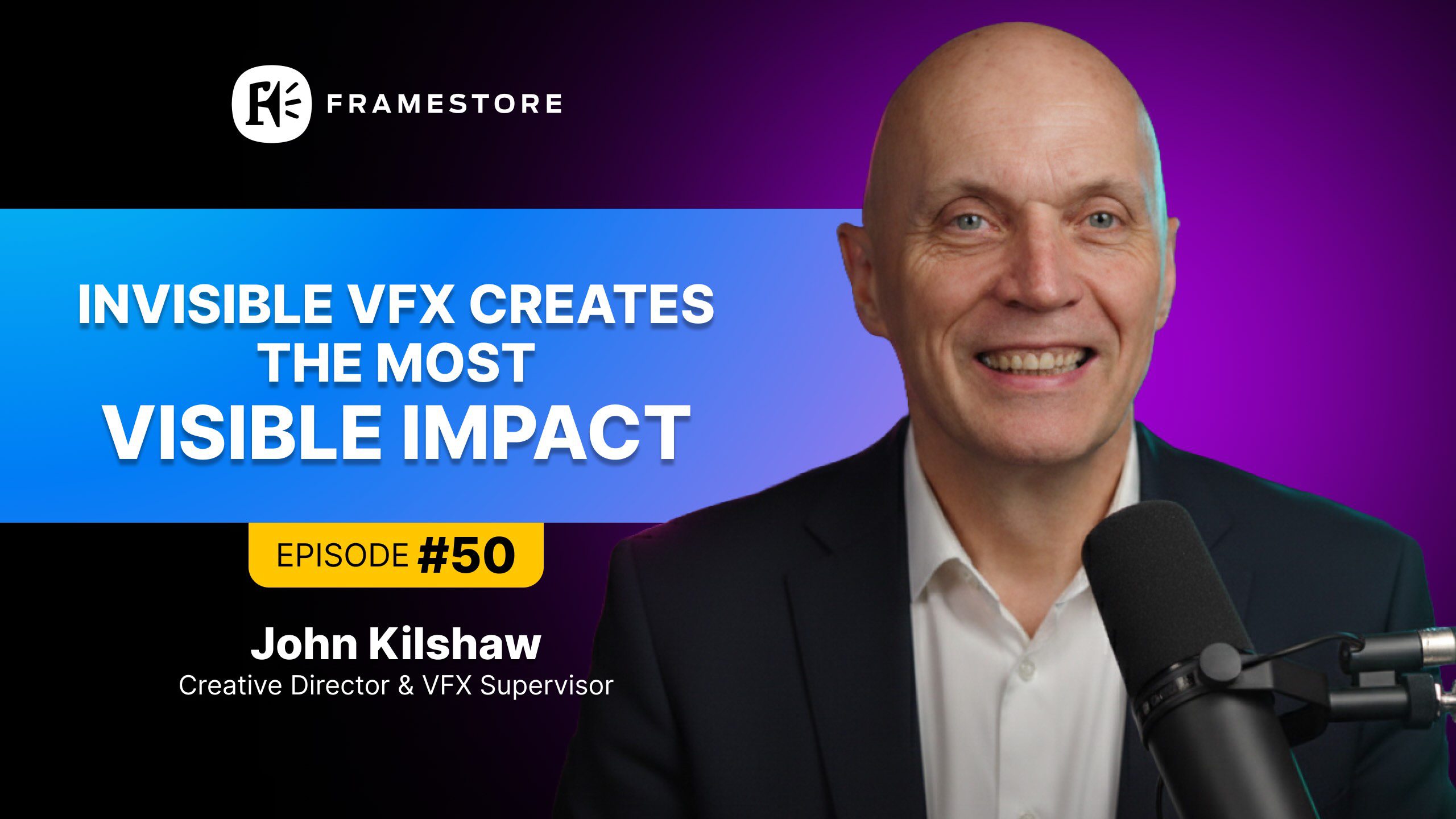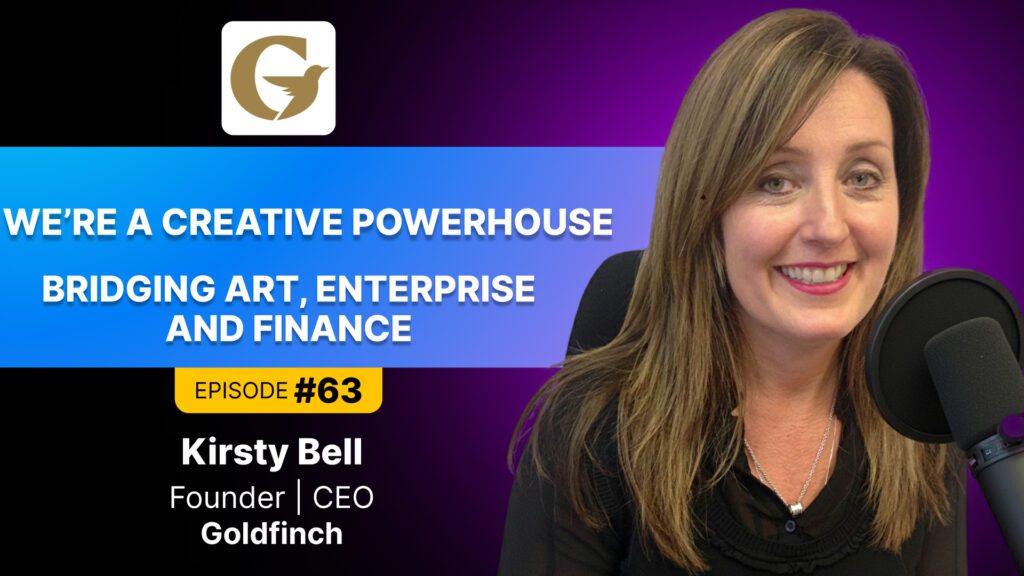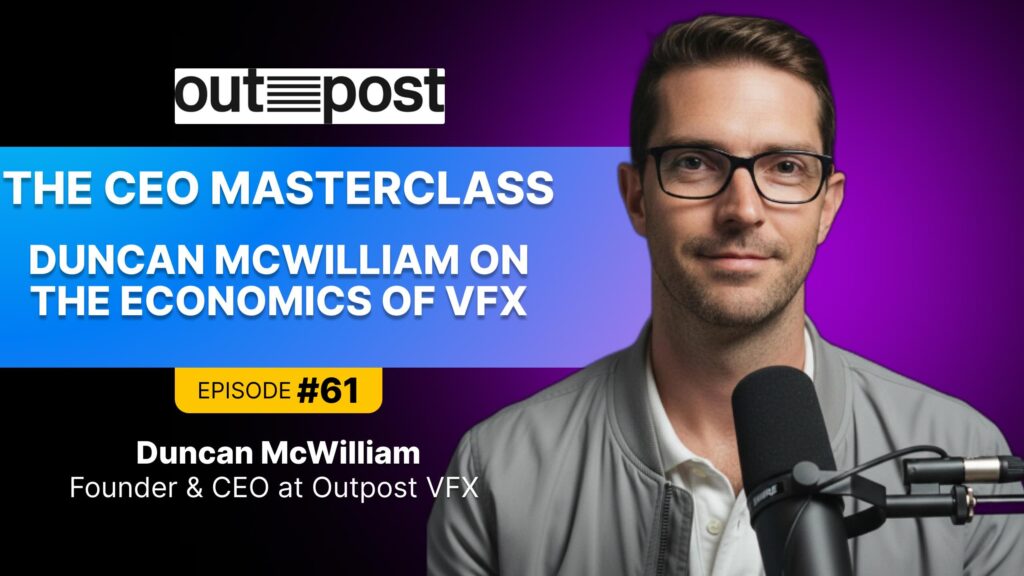Sometimes we’re brought in before a show is even greenlit—helping shape concepts, visual direction, and even influencing how scenes are written.
Podcast Chapters
| Timestamp | Chapter Title |
| 01:00 | John Kilshaw’s Career Journey |
| 05:26 | Recent Projects and Collaborations |
| 07:50 | Team Dynamics and Framestore’s Culture |
| 10:35 | Understanding Client Briefs |
| 15:36 | Managing Timelines and Expectations |
| 24:47 | Shifts in the VFX Supply Chain |
| 34:10 | Changing Unit Economics in VFX |
| 37:15 | Exciting Upcoming Projects |
| 39:45 | Challenges in the Age of AI |
SideFX and The Foundry have been on the cutting edge for decades, and the tools they’re creating now make what once took an afternoon achievable in a heartbeat.
Key Takeaways:
Sound Bites:
-
“Get the first weeks right, or the last weeks hurt.”
-
“Invisible VFX can be just as thrilling as creatures.”
-
“Great clients let you into their world early.”
-
“Technology’s job is to give us more time for beauty.”
-
“AI is changing how we talk about creativity, not just make it.”
About Framestore
Why Partner With Framestore?
-
Proven Track Record: Decades of award-winning work on globally acclaimed projects.
-
End-to-End Capability: From concept art to final VFX delivery across all genres.
-
Global Talent Pool: Access to world-class artists and supervisors in multiple continents.
-
Innovation-Driven: Early adoption of emerging tech, AI, and virtual production pipelines.
-
Collaborative Culture: Open, client-focused approach that integrates seamlessly with production teams.
In Conversation with John Kilshaw, Creative Director & VFX Supervisor at Framestore
In this special edition of the Vitrina podcast, we’ve summarized an insightful conversation with John Kilshaw, Creative Director & VFX Supervisor at Framestore. This transcript has been condensed and formatted into a Q&A for a quick and engaging read.
1. Vitrina: Can you give us an overview of your career journey, from your early days to your current role at Framestore?
John Kilshaw: I started at DNEG a few decades ago in an entry-level position as a runner. I was told that I didn’t have to run, but I tried to get everything done as quickly as possible. At that time, DNEG was different and you had to go through all the departments. This gave me a good grounding in all the different areas, which has been incredibly useful for me moving forward. From there, I went to ILM in Singapore to help develop an effects team, as effects were my area of specialization. I loved my time there and had the opportunity to work on the animated series Clone Wars. I then decided that television was much more interesting to me than the longer form, so I moved to New York. I worked at Method in New York, and then at Zoic, before Framestore reached out and asked me to build an episodic offering from New York.
“DNEG were quite different at that time. You had to go through all of the departments… So it gave you good grounding in all the different areas, which has been incredibly useful for me moving forward…”
2. Vitrina: Could you tell us about some of the recent projects that have been particularly rewarding or challenging, and the collaborative relationships that made them successful?
John Kilshaw: A turning point for what we were doing at Framestore was when we got to work with a supervisor and producer, Scott and Vic, on a show called Away for Netflix. They were really open to working with us, which allowed us to collaborate with them and stretch our muscles a little bit. That relationship has gone from strength to strength, and we’ve since worked with them on Cowboy Bebop and One Piece. We’ve also worked on projects like Avatar: The Last Airbender, The Perfect Couple, The Diplomat, and Dexter. The team at Framestore is incredible, and they just don’t know how to not hit home runs every day, which makes my job simple. Another memorable experience was working on Godfather of Harlem with showrunner Chris Brancato. He is an incredibly collaborative person who allowed me into his world to improve a scene where a leading character gets shot. He took a good idea and made it fabulous.
“Working on Godfather of Harlem with Chris Brancato. Chris is the showrunner. He’s an incredibly talented man at seeing stories and working stories together and figuring out how to bring new elements together.”
3. Vitrina: How do you maintain consistency and quality across different projects and teams while still making each one special?
John Kilshaw: Something I’ve always been aware of is that life is nothing more than people. If you took away all of Framestore’s awards, history, and reputation, you’d be left with an “utterly incredible group of highly talented people”. As soon as you realize that, you want to engage with the people, not the reputation. If you appreciate the people for what they are and what they bring to it, life becomes a lot easier. My approach is to try and figure out the knowledge in people’s minds, whether they are artists, directors, or showrunners, and understand where they want to be, what they want to do, and how they want to do it. Figuring out what you need to know and then working hard at it makes life incredibly easy.
“Life is nothing more than people…when you then see the team as that just pure talented bunch of people, makes life…you just want to engage with the people, not the reputation.”
4. Vitrina: How do you translate a client’s creative brief into a practical plan, and how do you handle the challenges of budget and timeline constraints?
John Kilshaw: Initially, clients rarely want to talk about technical details like polygon count or keyframes. They’re focused on the “emotive beats”—the story point within a scene. Our job is to understand their vision and help them realize it, sometimes by recommending ways to avoid visual effects altogether, as there might be a simpler way of shooting something. It’s about respecting their vision and not coming to them with your own ideas, and helping them find ways to achieve what they want to do. The most important part of a show, regarding the timeline, is the first six to eight weeks. It’s all about setting expectations and holding people accountable. If you get it right at the beginning, the last few weeks become a trickle, and you can build in enough time for new ideas to emerge.
“Very rarely do clients want to talk about polygon count, animation keyframes, texture maps, and all the technical detail…initially it’s all about the emotive beats. What’s the story point within this?”
5. Vitrina: The industry has seen major shifts with technology, from remote work during COVID to the rise of new tools. How does Framestore approach these changes?
John Kilshaw: Framestore has a lot of people assessing and looking at new technology all the time, but it’s a very open structure. If I see something, I can work with the people in the new technology areas, and we can all work together. Framestore is very open and involved. We have a cross-section of people, from those in their 20s to those like me in their 60s, with some bringing practical experience and some bringing new technology. A lot of the emerging technology at the moment has arrived at the right time because there is an appetite for so much content, but not enough capital to pay for all the work. These new tools will help us complete as much work as people need us to complete.
“A lot of the emerging technology at the moment has arrived in my mind at the right time because there is an appetite for so much content. If we look at all the content that the studios want to produce, but there’s physically not enough capital there to pay for all the work they want to do.”
6. Vitrina: How is the VFX supply chain changing, and what is your perspective on different storytelling traditions from various countries and markets?
John Kilshaw: The supply chain is changing, and VFX is now being brought in much earlier in the production cycle. While some studios are working more traditionally, others are much more proactive, asking us, “Here’s an idea. What do you think?”. Occasionally, we’ve even been involved in shows before they’ve been greenlit, with showrunners reaching out before they’ve gotten into the writers’ room to discuss concept art. It comes down to the needs of the show—sometimes it’s a pure implementation job, and other times we get involved in pre-development. As for different countries, it’s all about the storytelling traditions. I was lucky to work in Tokyo and saw that their way of telling stories is fundamentally different, which shows there’s a different way of thinking about narrative.
“Sometimes we’re able to get involved and help people in pre-development. And sometimes we help people with implementation. Whatever they require, we’ve got to be able to give them good answers.”
7. Vitrina: How has the shift in unit economics—from streaming to box office—impacted the VFX industry, and what role do cost and quality play in your work?
John Kilshaw: The new process is enabling us to get to the work that makes the work exceptional quicker. While this has an effect on cost, the real advantage is in the creative freedom it provides. For me, cost is important, but breathtaking moments are equally important. The more iterations we can get of a shot, the better the final result will be. The technology getting involved at the moment is allowing us to move beyond the simple set of work much more quickly and spend more time developing the wonderful parts of the work. This affects cost, but cost can’t be at the expense of the creative. The balance is cost and quality, and we have to make sure we don’t just go for cost and ruin quality.
“Cost is important, I get that, but actually breathtaking moments is equally as important.”
8. Vitrina: What are the key challenges you see for VFX supervisors in the immediate future, particularly with the rise of virtual production, AI, and generative AI?
John Kilshaw: I’ve been using generative AI for my own personal projects for two or three years now, and I was advised to get into it not for the media it could create but because my job as a VFX supervisor is about communication. When you use generative AI, you get a physical representation of the words you’ve used, which has allowed me to change my vocabulary. I think we need to look at ourselves, not the software, and see how the software can help us learn and develop. The most important part of the AI model for me is how I can grow. AI can help us get to creative answers quicker, and it can also cause us to ask questions that allow us to grow.
“Using generative AI for me has really allowed me to change my vocabulary.”





 London, United Kingdom
London, United Kingdom




